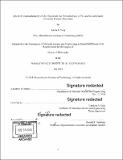| dc.contributor.advisor | Caroline A. Ross. | en_US |
| dc.contributor.author | Tang, Astera S. | en_US |
| dc.contributor.other | Massachusetts Institute of Technology. Department of Materials Science and Engineering. | en_US |
| dc.date.accessioned | 2019-07-18T20:34:43Z | |
| dc.date.available | 2019-07-18T20:34:43Z | |
| dc.date.copyright | 2018 | en_US |
| dc.date.issued | 2019 | en_US |
| dc.identifier.uri | https://hdl.handle.net/1721.1/121832 | |
| dc.description | Thesis: Ph. D., Massachusetts Institute of Technology, Department of Materials Science and Engineering, 2019 | en_US |
| dc.description | Cataloged from PDF version of thesis. "Feb 2019." | en_US |
| dc.description | Includes bibliographical references (pages 170-185). | en_US |
| dc.description.abstract | Multiferroic and magnetoelectric materials, in which the magnetic properties can be controlled via electric field and vice versa, hold the potential to be useful in several emerging memory technologies, including spin-wave devices and multi-state memory. Room temperature ferromagnetism and ferroelectricity are of great interest to the multiferroic and magnetoelectric community, as a key challenge in the field is engineering a material exhibiting room temperature ferroelectricity and ferromagnetism. Pulsed laser deposition grown oxygen-deficient Fe- (STF) and Co- (STC) substituted strontium titanate thin films are investigated for their microstructural, magnetic and ferroelectric properties. The films demonstrate room temperature ferromagnetism when grown under highly reducing conditions and in the case of STF, appear to exhibit room temperature ferroelectricity, though the magnetoelectric coupling is quite small. The impact of double-epitaxy on magnetism is investigated in STC. | en_US |
| dc.description.abstract | Double-epitaxy is a strain relaxation mechanism and microstructural feature observed in several perovskite oxides, and its effect on strain can in turn reduce the observed ferromagnetism of STC thin films. X-ray magnetic circular dichroism and x-ray absorption spectroscopy for STF thin films are also investigated. The results clarify the source of the observed ferromagnetism to be Fe²⁺ cations, which can be controlled via oxygen vacancy content, and a corresponding mechanism is suggested to explain how the ferromagnetism arises. The strong correlation between magnetic moment and strain is attributed to magnetoelasticity, and a preliminary study into the effect of epitaxial strain on oxygen-deficient STF is presented. Finally, attempts to alter the magnetic properties post-growth, with varying levels of success, are discussed. | en_US |
| dc.description.abstract | Although a method to manipulate the magnetic properties post-growth could prove useful to enabling easier processing and new applications for these materials, this work finds that post-growth manipulation of the magnetic properties is not completely reversible. The results presented in this work may provide insight into room temperature magnetism and ferroelectricity of related material systems. | en_US |
| dc.description.statementofresponsibility | by Astera S. Tang. | en_US |
| dc.format.extent | 185 pages | en_US |
| dc.language.iso | eng | en_US |
| dc.publisher | Massachusetts Institute of Technology | en_US |
| dc.rights | MIT theses are protected by copyright. They may be viewed, downloaded, or printed from this source but further reproduction or distribution in any format is prohibited without written permission. | en_US |
| dc.rights.uri | http://dspace.mit.edu/handle/1721.1/7582 | en_US |
| dc.subject | Materials Science and Engineering. | en_US |
| dc.title | Effect of nonstoichiometry on the magnetism and ferroelectricity of Fe- and Co-substituted strontium titanate thin films | en_US |
| dc.type | Thesis | en_US |
| dc.description.degree | Ph. D. | en_US |
| dc.contributor.department | Massachusetts Institute of Technology. Department of Materials Science and Engineering | en_US |
| dc.identifier.oclc | 1108620175 | en_US |
| dc.description.collection | Ph.D. Massachusetts Institute of Technology, Department of Materials Science and Engineering | en_US |
| dspace.imported | 2019-07-18T20:34:43Z | en_US |
| mit.thesis.degree | Doctoral | en_US |
| mit.thesis.department | MatSci | en_US |
